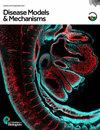Missense mutation (C667F) in murine β-dystroglycan causes embryonic lethality, myopathy and blood-brain barrier destabilization.
IF 4
3区 医学
Q2 CELL BIOLOGY
引用次数: 0
Abstract
Dystroglycan (DG) is an extracellular matrix receptor consisting of an α- and a β-DG subunit encoded by the DAG1 gene. The homozygous mutation (c.2006G>T, p.Cys669Phe) in β-DG causes Muscle-Eye-Brain disease with multicystic leukodystrophy in humans. In a mouse model of this primary dystroglycanopathy, approximately two-thirds of homozygous embryos fail to develop to term. Mutant mice that are born undergo a normal postnatal development but show a late-onset myopathy with partially penetrant histopathological changes and an impaired performance on an activity wheel. Their brains and eyes are structurally normal, but the localization of mutant β-DG is altered in the glial perivascular endfeet resulting in a perturbed protein composition of the blood-brain and blood-retina barrier. In addition, α- and β-DG protein levels are significantly reduced in muscle and brain of mutant mice. Due to the partially penetrant developmental phenotype of the C669F-β-DG mice, they represent a novel and highly valuable mouse model to study the molecular effects of β-DG functional alterations both during embryogenesis and in mature muscle, brain and eye, and to gain insight into the pathogenesis of primary dystroglycanopathies.小鼠β-肌收缩蛋白的错义突变(C667F)会导致胚胎死亡、肌病和血脑屏障失稳。
Dystroglycan(DG)是一种细胞外基质受体,由 DAG1 基因编码的 α- 和 β-DG 亚基组成。β-DG基因的同源突变(c.2006G>T, p.Cys669Phe)会导致人类肌肉-眼-脑疾病和多囊性白营养不良症。在这种原发性肌营养不良症的小鼠模型中,大约三分之二的同卵胚胎不能发育至足月。出生后的突变小鼠发育正常,但会出现晚发型肌病,组织病理学变化部分渗透,活动轮表现受损。它们的大脑和眼睛结构正常,但突变体β-DG在神经胶质血管周围内膜的定位发生了改变,导致血脑屏障和视网膜屏障的蛋白质组成紊乱。此外,突变小鼠肌肉和大脑中的α-和β-DG蛋白水平显著降低。由于 C669F-β-DG 小鼠具有部分穿透性发育表型,它们代表了一种新型且极具价值的小鼠模型,可用于研究胚胎发育过程中以及成熟肌肉、大脑和眼睛中 β-DG 功能改变的分子影响,并深入了解原发性肌张力障碍性疾病的发病机制。
本文章由计算机程序翻译,如有差异,请以英文原文为准。
求助全文
约1分钟内获得全文
求助全文
来源期刊

Disease Models & Mechanisms
医学-病理学
CiteScore
6.60
自引率
7.00%
发文量
203
审稿时长
6-12 weeks
期刊介绍:
Disease Models & Mechanisms (DMM) is an online Open Access journal focusing on the use of model systems to better understand, diagnose and treat human disease.
 求助内容:
求助内容: 应助结果提醒方式:
应助结果提醒方式:


